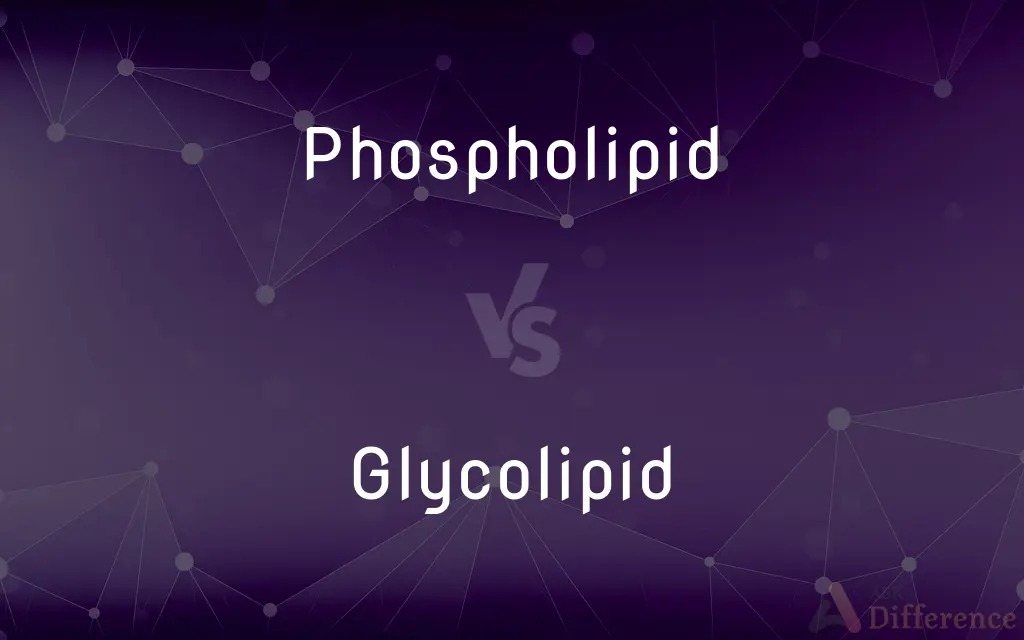Phospholipid vs. Glycolipid — What's the Difference?
Edited by Tayyaba Rehman — By Fiza Rafique — Updated on November 5, 2023
Phospholipids are major cell membrane components with a phosphate group, while glycolipids contain a sugar moiety and are involved in cell recognition.

Difference Between Phospholipid and Glycolipid
Table of Contents
ADVERTISEMENT
Key Differences
Phospholipids are a class of lipids that are a major component of all cell membranes as they can form lipid bilayers. These molecules consist of two fatty acid tails and a phosphate-containing group attached to a glycerol backbone. The presence of the phosphate group makes one end of the molecule hydrophilic (attracted to water), while the fatty acid tails are hydrophobic (repelled by water).
Glycolipids, in contrast to phospholipids, are composed of a glycerol backbone bonded to a sugar molecule and one or more fatty acid tails. Instead of a phosphate group, the sugar moiety, which can be glucose or galactose, renders the molecule amphipathic. Glycolipids are primarily found on the extracellular surface of the cell membrane and play a significant role in cell-to-cell interactions and recognition.
The role of phospholipids extends beyond just forming the structural foundation of the cell membrane; they are involved in cell signaling pathways and intracellular trafficking. Their amphipathic nature is crucial for the formation of vesicles and micelles, which are essential for the transport of lipids and other compounds in the aqueous environment inside the body.
Glycolipids are recognized by specific proteins and cells of the immune system, facilitating the immune response and cell adhesion. Their carbohydrate component extends outside the cell membrane, acting as markers for cellular recognition and also providing energy. They are less abundant in the cell membrane than phospholipids but play crucial roles in maintaining the stability and functionality of the cell surface.
In summary, phospholipids and glycolipids are both vital components of the cell membrane with differing structures and functions. Phospholipids provide the barrier that separates the cell from its environment, while glycolipids contribute to cell recognition and signaling. Both are necessary for the survival and proper functioning of cells in the body.
ADVERTISEMENT
Comparison Chart
Defining Group
Contains a phosphate group.
Contains a sugar moiety.
Primary Function
Forms the cell membrane's lipid bilayer.
Involved in cell recognition and signaling.
Location in Membrane
Throughout the bilayer, both layers.
Typically on the extracellular surface.
Role in Immunity
Less direct role in immune response.
Key for cell-to-cell communication in immunity.
Solubility Character
Amphipathic due to phosphate head and lipid tail.
Amphipathic due to sugar head and lipid tail.
Compare with Definitions
Phospholipid
Phospholipids are involved in various biological processes, including signaling and membrane trafficking.
Signaling pathways are often initiated by the activation of enzymes associated with phospholipids.
Glycolipid
Glycolipids serve as markers for cellular identification and communication.
Blood types are determined by specific glycolipids present on red blood cells.
Phospholipid
Phospholipids are a key component of cell membranes with a hydrophilic head and hydrophobic tails.
The cell's integrity is maintained by the phospholipid bilayer that envelops it.
Glycolipid
Glycolipids are membrane lipids with one or more sugar residues attached, important for cell recognition.
Glycolipids on the cell surface are crucial for tissue compatibility in organ transplants.
Phospholipid
They play an essential role in cell structure and function due to their amphipathic nature.
Phospholipids ensure that the cell's interior remains distinct from its surroundings.
Glycolipid
The sugar component of glycolipids can vary, influencing their function and location.
The diversity of glycolipids in the brain is essential for neuron function.
Phospholipid
Each phospholipid molecule is made up of two fatty acids, a phosphate group, and a glycerol backbone.
The synthesis of phospholipids involves attaching fatty acids to the glycerol molecule.
Glycolipid
They are found on the outer leaflet of the cell membrane, where they participate in interactions with the environment.
The cell's ability to adhere to its niche is partly attributed to glycolipids.
Phospholipid
Phospholipids can form vesicles, aiding in the transport of substances within the cell.
Medications utilize phospholipid vesicles to deliver drugs to specific cells in the body.
Glycolipid
Glycolipids can act as receptors for certain toxins and viruses, facilitating their entry into the cell.
The role of certain glycolipids in viral infections is a target for antiviral therapies.
Phospholipid
Phospholipids, also known as phosphatides, are a class of lipids whose molecule has a hydrophilic "head" containing a phosphate group, and two hydrophobic "tails" derived from fatty acids, joined by a glycerol molecule. Marine phospholipids typically have omega-3 fatty acids EPA and DHA integrated as part of the phospholipid molecule.
Glycolipid
Glycolipids are lipids with a carbohydrate attached by a glycosidic (covalent) bond. Their role is to maintain the stability of the cell membrane and to facilitate cellular recognition, which is crucial to the immune response and in the connections that allow cells to connect to one another to form tissues.
Phospholipid
A lipid containing a phosphate group in its molecule, e.g. phosphatidylcholine.
Glycolipid
A lipid that contains one or more carbohydrate groups.
Phospholipid
Any of various phosphorus-containing lipids, such as lecithin and cephalin, that are composed mainly of fatty acids, a phosphate group, and a simple organic molecule. Also called phosphatide.
Glycolipid
(biochemistry) An association of a carbohydrate and a phospholipid, such as phosphatidylinositol, found in cell membranes
Phospholipid
(organic compound) Any lipid, such as lecithin or cephalin, consisting of a diglyceride combined with a phosphate group and a simple organic molecule such as choline or ethanolamine; they are important constituents of biological membranes.
Glycolipid
(biochemistry) A similar compound lacking a phosphate group
Phospholipid
Any of various compounds composed of fatty acids and phosphoric acid and a nitrogenous base; an important constituent of membranes
Common Curiosities
Where are phospholipids found in a cell?
Phospholipids are found in the cell membrane, creating a bilayer that encloses the cell.
What is a phospholipid?
A phospholipid is a lipid molecule with a phosphate group, integral to forming cell membranes.
Are phospholipids involved in energy storage?
Phospholipids are not primarily used for energy storage; they are structural components of the cell membrane.
How do glycolipids contribute to cellular recognition?
Glycolipids have specific carbohydrate chains that are recognized by other cells, aiding in cell-cell communication.
How do glycolipids affect blood type?
Blood type is determined by the presence of specific glycolipids on the surface of red blood cells.
Can glycolipids be found in all cells?
Glycolipids are found in the cell membranes of eukaryotic cells, especially those involved in the immune system.
What is a glycolipid?
A glycolipid is a lipid attached to a sugar moiety, involved in cell recognition and signaling.
Can phospholipids be used as emulsifiers?
Yes, due to their amphipathic nature, phospholipids can act as emulsifiers, mixing fats with water.
How does the sugar moiety in glycolipids influence their function?
The sugar moiety can dictate the glycolipid's role in cell recognition, immunity, and interaction with other cells and molecules.
Do phospholipids have a role in the immune response?
Phospholipids can participate indirectly in the immune response but are not as involved as glycolipids.
Can phospholipids form micelles as well as bilayers?
Yes, phospholipids can form both micelles and bilayers depending on their concentration and the aqueous environment.
What distinguishes glycolipids from glycoproteins?
Glycolipids are lipids with a sugar component, while glycoproteins are proteins with a sugar component.
Do environmental factors affect phospholipid and glycolipid composition in the membrane?
Yes, environmental factors like temperature and pH can affect the composition and fluidity of phospholipids and glycolipids in the membrane.
Are glycolipids carbohydrates?
Glycolipids contain carbohydrate components, but they are not classified as carbohydrates; they are lipids with a sugar group.
What is the role of the phosphate group in a phospholipid?
The phosphate group in a phospholipid contributes to the molecule's amphipathic character, allowing it to interact with both water and lipids.
Share Your Discovery

Previous Comparison
Hungary vs. Hungry
Next Comparison
Secondly vs. SecondarilyAuthor Spotlight
Written by
Fiza RafiqueFiza Rafique is a skilled content writer at AskDifference.com, where she meticulously refines and enhances written pieces. Drawing from her vast editorial expertise, Fiza ensures clarity, accuracy, and precision in every article. Passionate about language, she continually seeks to elevate the quality of content for readers worldwide.
Edited by
Tayyaba RehmanTayyaba Rehman is a distinguished writer, currently serving as a primary contributor to askdifference.com. As a researcher in semantics and etymology, Tayyaba's passion for the complexity of languages and their distinctions has found a perfect home on the platform. Tayyaba delves into the intricacies of language, distinguishing between commonly confused words and phrases, thereby providing clarity for readers worldwide.














































